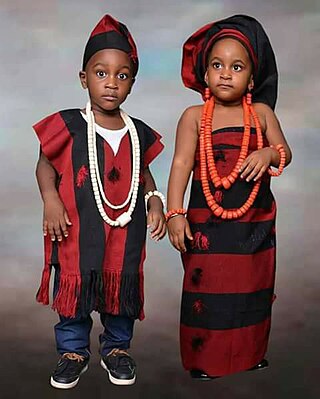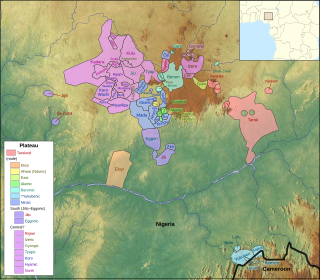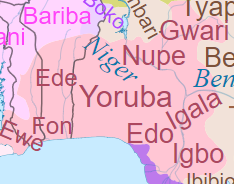Related Research Articles

The Tivoid languages are a branch of the Southern Bantoid languages spoken in parts of Nigeria and Cameroon. The subfamily takes its name after Tiv, the most spoken language in the group.

The Idomas are people that primarily inhabit the lower western areas of Benue State, Nigeria, and some of them can be found in Taraba State, Cross Rivers State, Enugu State, Kogi State and Nasarawa State in Nigeria. The Idoma language is classified in the Akweya subgroup of the Idomoid languages of the Volta–Niger family, which include Igede, Alago, Agatu, Etulo, Ete, Akweya (Akpa) and Yala languages of Benue, Nasarawa, Kogi, Enugu, and Northern Cross River states. The Akweya subgroup is closely related to the Yatye-Akpa sub-group. The bulk of the territory is inland, south of river Benue, some seventy-two kilometres east of its confluence with River Niger. The Idoma tribe are known to be 'warriors' and 'hunters' of class, but hospitable and peace-loving. The greater part of Idoma land remained largely unknown to the West until the 1920s, leaving much of the colourful traditional culture of the Idoma intact. The population of the Idomas is estimated to be about 3.5 million. The Idoma people have a traditional ruler called the Och'Idoma who is the head of the Idoma Area Traditional Council. This was introduced by the British. Each community has its own traditional chief such as the former Ad'Ogbadibo of Orokam, Late Chief D.E Enenche. The Palace of the Och'Idoma is located at Otukpo, Benue State. The present Och'Idoma, HRM, Elaigwu Odogbo John, the 5th Och'Idoma of the Idoma People was installed on the 30th of June, 2022 following the passing of his Predecessor HRH Agabaidu Elias Ikoyi Obekpa who ruled from 1996 to October 2021. Past Och'Idomas also include: HRH, Agabaidu Edwin Ogbu, who reigned from 1996 to 1997, HRH, Abraham Ajene Okpabi of Igede descent who ruled from 1960 to 1995 and HRH, Agabaidu Ogiri Oko whose reign took place between 1948 and 1959.

The forty or so Plateau languages are a tentative group of Benue–Congo languages spoken by 15 million people on the Jos Plateau, Southern Kaduna, Nasarawa State and in adjacent areas in central Nigeria.

There are over 525 native languages spoken in Nigeria. The official language and most widely spoken lingua franca is English, which was the language of Colonial Nigeria. Nigerian Pidgin – an English-based creole – is spoken by over 60 million people.
Chakato is a West Chadic language spoken in Plateau State, Nigeria. It was identified by Roger Blench in 2016. It is spoken by about 500 people in one village, Dokan Tofa, which is located on the Jos-Shendam road in Plateau State. Blench (2017) suggests that Chakato may be related to spurious records of the Jorto language. Chakato speakers claim that their language is closely related to Goemai.

The Volta–Niger family of languages, also known as West Benue–Congo or East Kwa, is one of the branches of the Niger–Congo language family, with perhaps 70 million speakers. Among these are the most important languages of southern Nigeria, Benin, Togo, and southeast Ghana: Yoruba, Igbo, Bini, and Gbe.

Idoma (Ìdɔ́mà) is the second official language spoken in Benue State in southeast-central Nigeria, by approximately one million people. The Idoma language is made up of the dialects of Agatu, Edumoga, Otukpo, Otukpa, Orokam, Akpa Agila, Utonkon, Igede, Etilo, Iyala. The Idoma people are predominantly hunters, farmers and fishermen. They are bordered to the north by Nasarawa, south by cross river, east by Taraba and west by Enugu and Kogi States.
Oko (ɔ̀kɔ́), also known as Ogori-Magongo and Oko-Eni-Osayin, is a dialect cluster spoken in Nigeria. It appears to form a branch of the "Nupe–Oko–Idoma" group of Niger–Congo languages. Most Oko speakers also speak Yoruba as a second language. The language is spoken in and around the towns of Ogori and Magongo in southwestern Kogi State, close to the Ondo and Edo state borders.
Zeem, or Chaari, is an endangered Chadic dialect cluster of Nigeria, whose speakers are shifting to Hausa. Dyarim is closely related.
Alumu is a Plateau language spoken by approximately 7,000 people in Nassarawa State, Nigeria. It has lost the nominal affix system characteristic of the Niger–Congo family.
The Koma language is a language cluster belonging to the Duru branch of Savannas languages of Cameroon. Blench (2004) includes three varieties separated in Ethnologue, Koma Ndera, Gɨmne, and Gɨmnɨme; within Koma Ndera, speakers of the marginal dialects, Gomnome and Ndera, can scarcely understand one another, though both understand the central dialect, Gomme.
Yace (Yache) is an Idomoid language of Cross River State, Nigeria. It is spoken in Yala LGA, Alifokpa, Imbuo, Maa, Osina, Uchu, and Wonye. Yace is closely related to the Akpa language.
Eloyi, or Afu (Afo) or Ajiri, is a Plateau language of uncertain classification. It is spoken by the Eloyi people of Agatu LGA and Otukpo LGA of Benue State and Nassarawa State in Nigeria.
Ahwai, also called the Ndunic languages, is a Plateau language cluster spoken to the southwest of Fadan Karshi in Sanga LGA, Kaduna State, Nigeria. Most villages are located at the foot of the Ahwai Mountains in Kaduna State.
Etulo is an Idomoid language of central Nigeria.
Pe, also spelled Pai or Pye, is a minor Plateau language of southeastern Plateau State, Nigeria. It is classified as a Tarokoid language by Roger Blench (2023).
Yala (Iyala) is an Idomoid language of Ogoja, Nigeria. Blench (2019) lists dialects as Ikom, Obubra, and Ogoja.
Kakanda is a Nupoid language of Nigeria. Kakanda is spoken in and around Kupa and Eggan. There are scattered villages stretching from the Niger-Benue confluence to as far as Muregi. There are at least 10,000 people. It is most closely related to Gupa and Kupa, although there are also some similarities with Ebira.
The Eloyi are an ethnic group of central Nigeria. About 100,000 people identify themselves as Eloyi. They are related to the Idoma ethnic group.
Nigbo is an extinct Plateau language of Nigeria. It was spoken near Agameti on the Fadan Karshi-Wamba road near Sanga LGA, Kaduna State. The language, listed in Blench (2012) and (2019), is not reported in Ethnologue or Glottolog. It is presumably an Alumic language based on its proximity to Akpondu, a language closely related to Alumu and Tesu.
References
- ↑ Blench, Roger. 2007. The Eloyi language of Central Nigeria and its affinities.
- ↑ Blench, Roger (2019). An Atlas of Nigerian Languages (4th ed.). Cambridge: Kay Williamson Educational Foundation.
![]() This article incorporates text available under the CC BY 3.0 license.
This article incorporates text available under the CC BY 3.0 license.